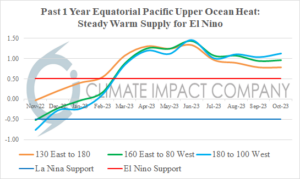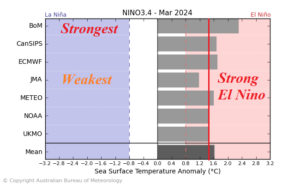Drought Developing in Australia Although Patchy Rains In 15-Day Outlook
11/02/2023, 5:55 am EDTMarket News: Redeveloping Low Water Hazard on the Mississippi; Scorching Hot Brazil Ahead
11/08/2023, 8:06 am ESTHighlight: El Nino support remains steady.

Fig. 1: Upper ocean heat for each month of the past year across the equatorial Pacific Ocean.
Discussion: The upper ocean heat across the equatorial Pacific Ocean remains steadily very warm and supportive of maintaining the current robust oceanic El Nino episode (Fig. 1). The El Nino climate has lagged the oceanic signature. Multivariate ENSO index (MEI) is a good indicator of the atmospheric reaction to equatorial East Pacific warming and only recently shifted into El Nino classification. A new MEI value for SEP/OCT will be issued later this week. Forecast models are agreeable on peak strength of El Nino 2023-24 in January. Decelerating strength follows. Comparing El Nino intensity next March according to a collection of leading forecast models indicates a range of solutions from lingering strong EL Nino according to the Australia Bureau of Meteorology to a weak El Nino signature predicted by the Japan Meteorological Agency (Fig. 2).

Fig. 2: The Australia Bureau of Meteorology collects all dynamic model ENSO phase projections for next March.
